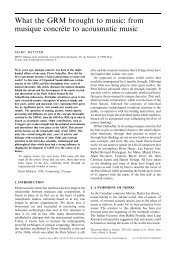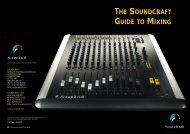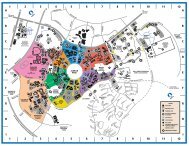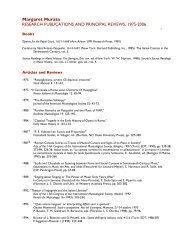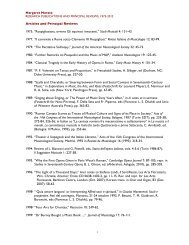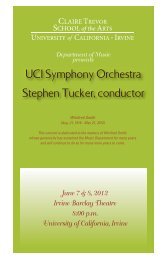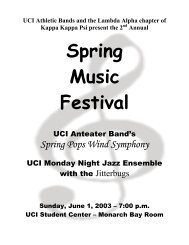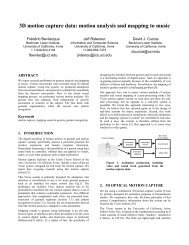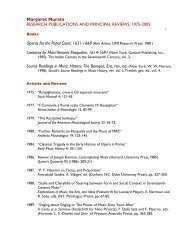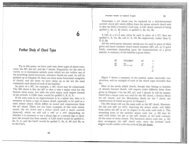âRoots and Branchesâ - Music - University of California, Irvine
âRoots and Branchesâ - Music - University of California, Irvine
âRoots and Branchesâ - Music - University of California, Irvine
You also want an ePaper? Increase the reach of your titles
YUMPU automatically turns print PDFs into web optimized ePapers that Google loves.
John Rosamund Johnson (1873 – 1954)<br />
Matilda Sissieretta Joyner Jones – “Black Patti” (1869 – 1933) – The Black Patti<br />
Troubadours/The Black Patti <strong>Music</strong>al Comedy Company – a group <strong>of</strong> singers, dancers,<br />
comedians <strong>and</strong> jugglers performing shows such as A Trip to Africa, In the Jungles, Captain<br />
Jaspar, <strong>and</strong> Lucky Sam from Alabam.<br />
Ground-breaking performances include:<br />
1893 – Will Marion Cook composes Scenes from the Opera <strong>of</strong> Uncle Tom’s Cabin for<br />
performance at the Chicago World’s Fair – a performance that was cancelled;<br />
1898 performance <strong>of</strong> Clorindy; or, The Origin <strong>of</strong> the Cakewalk, composed by Will Marion<br />
Cook in collaboration with Paul Laurence Dunbar.<br />
COMMENTARY: The haze <strong>of</strong> complexional prejudice has so much obscured the vision <strong>of</strong> many persons, that<br />
they cannot see (at least, there are many who affect not to see) that musical faculties, <strong>and</strong> power for their artistic<br />
development, are not in the exclusive possession <strong>of</strong> the fairer-skinned race, but are alike the beneficent gifts <strong>of</strong> the<br />
Creator to all his children. Besides, there are some well-meaning persons who have formed, for lack <strong>of</strong><br />
information which is here afforded, erroneous <strong>and</strong> unfavorable estimates <strong>of</strong> the art-capabilities <strong>of</strong> the colored<br />
race.<br />
James M. Trotter, <strong>Music</strong> <strong>and</strong> Some Highly <strong>Music</strong>al People (Boston, 1878), p.4.<br />
1900 - 1945 --- Generation II - Nationalists<br />
The African American Art Song: The Evolution, Preservation <strong>and</strong> Performance<br />
• During this Period <strong>of</strong> Evolution, Preservation <strong>and</strong> Adaptation, composers begin to create a solovoice,<br />
art-song repertoire inspired by the folk melodies <strong>of</strong> the Spiritual, <strong>and</strong> these works, known<br />
as The Concert Spiritual, become an important component <strong>of</strong> the performance repertoire <strong>of</strong> a<br />
growing number <strong>of</strong> pr<strong>of</strong>essional African American singers. The tradition begins with Harry T.<br />
Burleigh’s 1916 arrangement <strong>of</strong> Deep River <strong>and</strong> Edward Boatner’s 1918 arrangement <strong>of</strong> Give Me<br />
Jesus. This body <strong>of</strong> song contributes to the creation <strong>of</strong> a style <strong>of</strong> American Nationalism in music.<br />
Much <strong>of</strong> the work <strong>of</strong> the African American composer <strong>and</strong> performer was celebrated, supported<br />
<strong>and</strong> preserved by the newly formed National Association <strong>of</strong> Negro <strong>Music</strong>ians (founded in 1919).<br />
• Composers <strong>of</strong> the Renaissance<br />
Renaissance – A cultural, intellectual <strong>and</strong> social phenomenon <strong>of</strong> the 20 th century in the United<br />
States in which African Americans become among the most prominent cultural <strong>and</strong> political<br />
personalities. The phenomenon is centered originally in Harlem, <strong>and</strong> has additional flowerings in<br />
Chicago <strong>and</strong> numerous other urban areas. It is a period that some observers describe as<br />
embracing the hope for black uplift <strong>and</strong> interracial interaction <strong>and</strong> empathy.<br />
• Generation II: Artists <strong>of</strong> this New Negro Movement, many <strong>of</strong> whom are trained at the top<br />
conservatories <strong>and</strong> universities <strong>of</strong> America, use their work to enhance the public underst<strong>and</strong>ing<br />
<strong>of</strong> African American culture. African American composers embrace what is known as the “Blues<br />
aesthetic” within their work. Composers create many Art Songs, song cycles, operas <strong>and</strong> Creole<br />
shows utilizing the poetry <strong>of</strong> Harlem Renaissance poets, e.g. Arna Bontemps, Countee Cullen,<br />
Paul Laurence Dunbar, Langston Hughes, Claude McKay. Composers <strong>of</strong> the 1900 – 1940 period<br />
include:<br />
Edward Hammond Boatner (1898 – 1981)<br />
Margaret Bonds (1913 – 1972)<br />
Harry Thacker Burleigh (1866 – 1949)<br />
Cecil Cohen (1894 – 1967)<br />
Will Marion Cook (1869 – 1944)<br />
William Levi Dawson (1899 – 1990)<br />
Robert Nathaniel Dett (1882 – 1943)<br />
Carl Diton (1886 – 1962)<br />
Lillian Evanti (1890 – 1967)<br />
William Christopher H<strong>and</strong>y (1873 – 1958)



